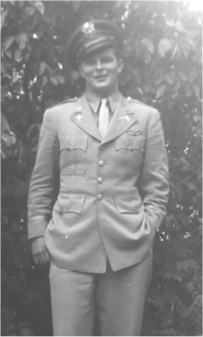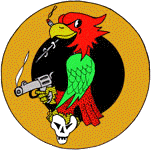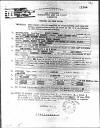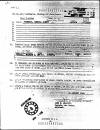|
HONORING THE MEMORY OF
CARROLL A. PETERSON
Carroll A. Peterson 1922 - 1945
 It was sometime during the year 1944 that my mother and
Capt. Carroll Albert Peterson became engaged to be married. I have practically no personal
information about him. She told me his name once and said he had died in
WWII. My mother passed away in the fall of 2002. A box of the family mementos
made its way to my house. Among the things were some old photographs and
newspaper articles about Carroll. A letter
to my grandfather from the Army Air Forces Headquarters in Washington
dated October 12, 1945, really piqued my interest. I wanted to find out who this
man was. Obviously, my mother thought he was someone very special. It was sometime during the year 1944 that my mother and
Capt. Carroll Albert Peterson became engaged to be married. I have practically no personal
information about him. She told me his name once and said he had died in
WWII. My mother passed away in the fall of 2002. A box of the family mementos
made its way to my house. Among the things were some old photographs and
newspaper articles about Carroll. A letter
to my grandfather from the Army Air Forces Headquarters in Washington
dated October 12, 1945, really piqued my interest. I wanted to find out who this
man was. Obviously, my mother thought he was someone very special.
Carroll was a former carrier for
the Grand Rapids Herald. He graduated from Union High School in 1939
and was in his second year at Junior College when he enlisted in the
air corps in March 1942. He was commissioned October 21, 1942, and
received a promotion to captain in June 1944.
He was the son of Helmer & Elna
(Johnson) Peterson of 241 Sunset Ave. NW, Grand Rapids. Carroll had
five brothers and three sisters named Maurice, Roy, Richard, Kent,
Donald, Helen, Margaret, and Eleanor.
Military Record
 Carroll went overseas in November 1943.
He was home in Grand Rapids the summer of 1944, but in October returned to
action in Europe. He had more than 100 missions and 263 combat hours on his
record. He wore the Silver Star for gallantry, a Distinguished Flying Cross with
Oak Leaf Cluster, and an Air Medal with 18 Oak Leaf Clusters. Carroll went overseas in November 1943.
He was home in Grand Rapids the summer of 1944, but in October returned to
action in Europe. He had more than 100 missions and 263 combat hours on his
record. He wore the Silver Star for gallantry, a Distinguished Flying Cross with
Oak Leaf Cluster, and an Air Medal with 18 Oak Leaf Clusters.
Carroll was featured in dispatches from the Nazi front in 1944
as commander of a Thunderbolt squadron which destroyed 22 German tanks and
trucks in one dive bombing foray. He was attached to the 379th Fighter Squadron
of the 362nd Fighter Group, 9th Air Force.
At the end of 1944, Carroll was chosen the Top Artillery Buster,
one of the nine best target killing pilots in the 9th Air Force.
The Aircraft: P-47
 The
Republic P-47 aircraft is one of the most famous military machines. Much has
been written about the powerful, rugged fighter plane, and many web sites are
dedicated to the Thunderbolt's important place in history. In addition, there
are many sites with reference to the 379th Fighter Squadron. The
Republic P-47 aircraft is one of the most famous military machines. Much has
been written about the powerful, rugged fighter plane, and many web sites are
dedicated to the Thunderbolt's important place in history. In addition, there
are many sites with reference to the 379th Fighter Squadron.
Missing In Action
On January 22, 1945, a very impressive military career came to a
sudden and tragic end over Luxembourg. Carroll took off with his squadron from his base at Rouvres [Etain], France
"on a fighter bomber mission to Prum, Germany." Other members of his squadron
reported that they encountered fierce anti-aircraft fire over [Hosingen], Luxembourg. As a
result, his Thunderbolt sustained sufficient damage to cause it to fall into a
spin. It is probable that Carroll was injured and consequently was unable to
bail out before the fatal crash. Official reports indicated that visibility was
2 to 8 miles; low clouds. The aircraft was seen to crash at 16:15 hours.
However, it would be one and a half months before his death would be
confirmed. He was listed "missing" until Tuesday, March 6, when it was reported
that he was killed on the day he was first reported missing. Presumably this
report was
about the time the wreckage of his aircraft was found. The following photographs
portray the wreckage of Carroll's airplane.

Crash site is apparently an open field with a small stream in
evidence. |

Wreckage is strewn across a wide area. |

The tail section of the aircraft showing the number "420728" |

Official Detailed Map of Crash Site |

Missing Air Crew Report p. 1 |

Missing Air Crew Report p. 2 |
The aircraft: P47D-30
Serial number: 44-20728
Engine: R-2800-59
Weapons: (8) .50 Caliber Machine Guns
379th FIGHTER SQUADRON
Office of the Intelligence Officer
USAAF Sta #A-82 APO #141
23 January 1944
STATEMENT OF LT. BRANDON D. NUTTALL, AIR CORPS
"On January 22, 1945, I was flying No. 2 position for Blue
Leader, Capt. C. A. Peterson, on a close support mission over enemy territory
(L-065795). We crossed in and Blue Leader identified several convoys of enemy
vehicles below. We orbited and made two strafing passes on these vehicles. On
the third pass, I followed Blue Leader down on several tanks. Blue Leader made
one evasive turn to the right, then pulled up to the left to go in again. At the
top of his pull up, around 1500 feet, I saw his plane jerk violently. It
continued its arc and caught fire almost immediately burning fiercely from the
cockpit back. Flame covered the rear fuselage and tail surfaces. I continued
high speed evasive action and watched the plane go down. At around 1000 feet, I
saw the canopy jettison and maps blow out of the cock-pit. At this point the
ship went into a slow spin and crashed into the lower side of a small valley
(P-8558). The plane did not explode when it hit. Fire belched from under the
wings and engine as it hit but did not seem to burn to fiercely. My attention
was distracted by close flak for a moment but I looked back and could see no
open parachute nor anyone running from the crash. I then called the crash into
Green Leader and joined Blue 3 for the rest of the mission."
BRANDON D. NUTTALL
2nd Lt., Air Corps
See Pilot log:
http://home.kih.net/~bnuttall/id4.html
Last Rest in Christ
 Carroll
A. Peterson Carroll
A. Peterson
Major, U.S. Army
O-732346
379th Fighter Squadron, 362nd Fighter Group
Entered the Service from: Michigan
Died: January 22, 1945
Buried at: Plot E Row 13 Grave 31
Henri-Chapelle American Cemetery
Henri-Chapelle, Belgium
Awards: Silver Star, Distinguished Flying Cross with Oak Leaf Cluster, Air Medal
with Oak Leaf Cluster
More information on this cemetery can be found at:
www.WellsWooster.com
|